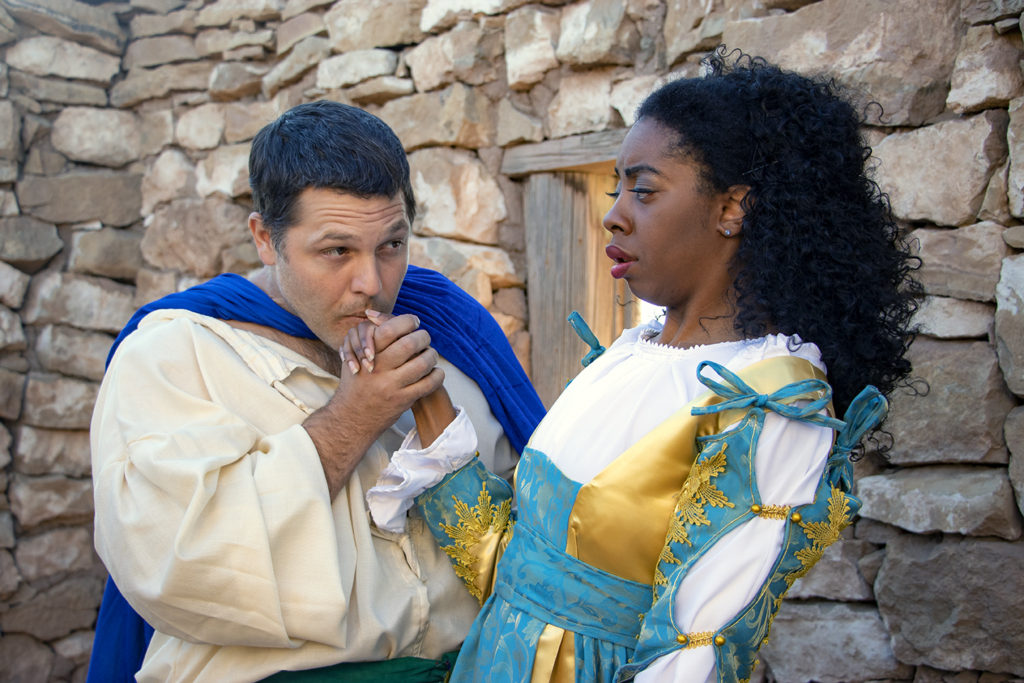Right now, in the Allen Elizabethan Theatre at the Oregon Shakespeare Festival in Ashland, Oregon, a new play is in the repertory. It was written by (fun fact) the most-produced American playwright of the current theatre season (outside of Shakespeare), Lauren Gunderson. The play is called The Book of Will and concerns the assembly and printing of the so-called First Folio edition of Shakespeare’s plays, published some seven years after his death. I haven’t seen or read the play (more than what’s freely available online, that is), but it is billed as a sort of paean to the Bard and his works; a lively, if fanciful, history of events we know very little of, sad to say, but which by golly we’re glad occurred (however they occurred) because without them you wouldn’t be reading this—nor coming to various sites in beautiful northern Arizona settings to see Flagstaff Shakespeare Festival performances.

“What if all the words were lost?” poses a headline at O-Shakes’s web page about the play. What indeed. The world would be a very different place, no doubt whatsoever. Well, for one thing, there’d be no Shakespeare festivals anywhere—beautiful outdoor settings or not! And so much more than that: the whole rich, heart-opening, weep-inducing, belly-laughing, tragical, astounding, uproarious mess that is Shakespeare’s canon—gone! A void in the world? Nay, a veritable cavernous maw, I say!
Whoa, dial it down, Ben. We’re all on the same page here—those brilliant, scintillant pages that Heminges and Condell managed to wrest from the transient flux of Elizabethan (well, Jacobean) life 400 years ago. May your place in Heaven be assured, you great men of the theatre!
And truly, that’s the crux: these forward-looking men committed to paper (itself a transient form, but let that go) those great stories and poetry of the King’s Men’s man. Think about that: dramatic art on paper. The soaring words and themes and living drama of the Western world’s greatest dramatist flattened out like so many squashed ants. How could it be done? More importantly, how can those squashed ants be resuscitated into living drama once again? How can those dry, flat symbols magically expand into three dimensions? Four—bodies in motion in space and voices on the air!
As a symphony orchestra brings to life the great works of Mozart or Beethoven or Mendelssohn from the lifeless lines and dots of a symphonic score, we, a company of actors, must first interpret, then breathe our own life into, this flat suggestion of an idea of a concept! Impossible!
And yet…
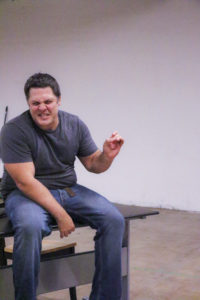 As the text and speech coach for Flagstaff Shakespeare’s production of The Taming of the Shrew, that’s the nut I’m trying to crack. And such a delicious, impossible nut! Our director, Jesse Kamps, and fearless leader Dawn Tucker have entrusted me with the task of helping my fellow actors bring to vibrant life the “mere words” of a man 400 years dead. My task is twofold. The first part is to make sure the actors understand the text. What do the words mean? What is the sense of a phrase, a line, a speech? What is happening in the scene? Does this word or phrase mean the same thing now as it did when Shakespeare wrote it? The second part is to make sure the audience understands the same text, but this time as speech. The difference between text and speech, though it may appear largely mechanical (anyone who can read could do it, right?), is fraught with challenges. And the difference between merely well-spoken text and living, breathed-and-breathing Shakespearean language that is both comprehensible and bursting with meaning—well, that’s another matter entirely.
As the text and speech coach for Flagstaff Shakespeare’s production of The Taming of the Shrew, that’s the nut I’m trying to crack. And such a delicious, impossible nut! Our director, Jesse Kamps, and fearless leader Dawn Tucker have entrusted me with the task of helping my fellow actors bring to vibrant life the “mere words” of a man 400 years dead. My task is twofold. The first part is to make sure the actors understand the text. What do the words mean? What is the sense of a phrase, a line, a speech? What is happening in the scene? Does this word or phrase mean the same thing now as it did when Shakespeare wrote it? The second part is to make sure the audience understands the same text, but this time as speech. The difference between text and speech, though it may appear largely mechanical (anyone who can read could do it, right?), is fraught with challenges. And the difference between merely well-spoken text and living, breathed-and-breathing Shakespearean language that is both comprehensible and bursting with meaning—well, that’s another matter entirely.
Consider how we humans communicate. Before the advent of all our many analog and digital communication devices, human communication (aside from writing) was a full-body experience. For those possessed of all senses, we “spoke” across the wide bandwidth of sight and sound, producing a complex of audio-visual information directed to the receiver. You don’t have to be Italian to appreciate the value of a good gesture! In the Digital Age, we’ve constricted that bandwidth enormously, into narrow streams of inflexible data that tend to denude, rather than enrich, communication. Just think of how often intentions are mistaken in a text message or an online comment thread and you’ll know exactly what I’m on about.
Shakespearean language, though essentially modern English (technically “early modern English”), is different from our contemporary English not so much because of linguistic changes in vocabulary, syntax, and grammar—though these do differ, somewhat, from ours—but because of the particular ways Shakespeare used the language at his disposal.
He pushed its boundaries and then cracked it wide open. I imagine that, were he alive today, he would be writing things as newfangled and mind-blowing now as they must have seemed to the Elizabethans then. He rose above the limitations of his own language and made it a servant to his art. That’s what makes it hard to understand more than the changes in English over the centuries. He was a poet—he used language differently from others, elevated it to a new plane.
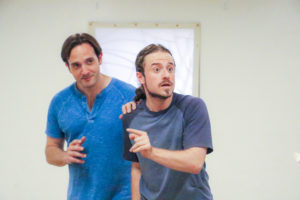
But in his plays Shakespeare wasn’t, strictly speaking, writing poetry—he was writing drama. It was meant to be seen and heard: enacted. So merely speaking the text aloud in a clear voice is insufficient to convey its complex meaning from actor to audience. The task requires another avenue, another methodology. I believe that methodology to be the subtle, unique combination of an actor’s understanding of the text expressed through a range of vocal properties (inflection, pitch, rhythm, pacing) plus the bodily aspects of acting: posture, gesture, facial expression, carriage, and more. Done well, the resultant mixture is rich with expression and can render complex and expansive ideas into a perceptible form that can be easily understood by an audience, regardless of the differences in the language itself.
And that’s where I’m investing my efforts as text and speech coach. I must examine each actor’s expressive output and evaluate its effectiveness, then help them to modulate or enhance that output when it is ineffective or its meaning is unclear.
That work requires an appreciation of the actor’s gifts and limitations, an ability to adapt to their style of learning, and a thorough knowledge of the tools available to assist them in this quest to convey meaning. Easy-peasy (he said hopefully)!
It is indeed fortunate that I find myself working with a cast with many gifts and a great enthusiasm to succeed in telling Shakespeare’s story. We’re all definitely committed to producing the clearest, most delightful, thoughtful and engaging Shrew that we possibly can. And you, our dear and commendable audience, will determine how well we have succeeded.
 Enjoy the show!
Enjoy the show!
Ben Gorman
As the 2018 FlagShakes season quickly approaches, we wanted to get behind the scenes and introduce you to some of the talented artists you’ll see on stage. We sat down with Ryan Jenkins, who is playing Katherine, and Keath Hall, who is playing Petruchio. We know you’ll love hearing more about them and the insights they bring to the roles.
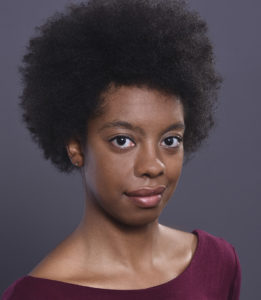 What has been your favorite role with FlagShakes?
What has been your favorite role with FlagShakes?
RJ: This is only my second role with FlagShakes. When I played Third Witch/Third Murderer last summer, it was fun to have the opportunity to experiment with playing both a human and supernatural antagonist. Coming back this season has been amazing. Working with friends again, I feel like my favorite role so far has been being an actor in the company!
KH: Last year was my debut with FlagShake,s and I was honored to play Macduff and the bloody sergeant. Petruchio this year has been both challenging and exciting; thus far, it has been my favorite.
How does this role compare to others you’ve done?
RJ: Katherine is a force to be reckoned with. Similar to the Weird Sisters, she refuses to play by anyone else’s rules. People are drawn to her but also fear her. However, the fact that she is a love interest presents unique challenges I didn’t have playing a witch. I have played a headstrong woman-in-charge before, and I have played a love interest/ingenue, but Katherine is the first role where I have to be a combination of the two. She’s more aggressive and violent than Beatrice [in Much Ado About Nothing] but shares the same sharp intellect and wit.
KH: Petruchio is odd and an extremely unreliable source of information in the play. Macduff is a pretty straightforward, straight-laced character. A character like Falstaff is at least a consistent liar, while Petruchio is unpredictable in behavior and ideals. At times, his words seem patriarchal, but at other times he seems to be wholly set against that same system. His language also shifts from something crass to that of elevated poetry. There is a lot more left open for interpretation depending on which moments the actor plays as sincere.
 Do you have a dream role, Shakespeare or otherwise?
Do you have a dream role, Shakespeare or otherwise?
RJ: I would love to be Lady Macbeth, Portia (Merchant of Venice), and Titania (A Midsummer Night’s Dream). My dream role would be a performance capture or voice actor in a video game or movie (like “Avatar!)
KH: Still waiting for a Viking production of Hamlet. Otherwise, I have been eyeing Coriolanus for a while.
What’s your favorite quality of this character? Least favorite?
RJ: I love that Katherine fearlessly speaks her mind. “No” is a complete sentence to her (but she’s a Shakespeare character so she’s obligated to say more), and it comes without apology. She owns her intelligence. I don’t like that Katherine uses physical violence to get her way. I am not a confrontational or physically intimidating person, and I think it takes an unnecessary amount of energy to be someone who is—on stage or off.
KH: Petruchio has an energy and a grounded understanding of the world around him. This gives him some freedom to observe, comment on, and abuse some negative elements in people and society. That is fun. Unfortunately, to “end successfully” he also must impose his experience and worldview upon Kate, abusing her and several others in the process, for what he deems to be a greater good.
Since these roles have been performed by thousands of people, do you have a new take? What are you hoping to highlight in this production?
RJ: I think this role is an opportunity to explore my own ever-expanding beliefs regarding womanhood, relationships, gender roles, social conventions, love, and marriage and how to express those philosophies through Katherine. My experience with these aspects of life as a mid-twenties woman of color in a long-term relationship in 2018 has to lead to a uniquely complex perspective on Kate’s pathology and highlights how women today are still discovering and defending their own convictions on these lifestyle topics.
KH: The play is very much of a time and place, though it deals with some universal themes. Following the current issues regarding consent, the #MeToo movement and the state of feminism in the US, we have attempted to present the play in a way that asks questions to further these conversations as opposed to answering them.
My hope is to highlight the idea of marriage as a unification, a team. In this particular case, two broken people become an unstoppable force. We have set the play classically in a patriarchal world, and so to succeed the couple must play by those rules, at least superficially. Ideally, the audience will walk away contemplating the importance of love, sacrifice, and the value of a partner.
How important is the chemistry between these two characters? How are you tackling that in rehearsals?
RJ: Kate and Petruchio’s story has no dynamic without chemistry. Keath is not afraid to try anything and everything to get a reaction, which encourages me to stay as emotionally fluid as I can, and find moments where Katherine can be just as playful, witty, or impulsive!
KH: Kate and Petruchio are like fires that should build on each other. Ryan and I are good friends who are very passionate about these characters. There is a huge amount of trust we have put on each other and in our director Jesse Kamps. Negotiating the intimacy has been as honest and as safe a process as possible.
How does FlagShakes’ commitment to original staging practices help you communicate the character?
RJ: Direct address challenges me to remember I’m sharing with the audience just as much as my stage counterparts. Katherine’s biggest weapon is her tongue, so my dedication to fully expressing the language, physically and vocally, has to be as sharp and deliberate (and somehow effortless) as she is. She wants to be seen and heard at all times, so being committed to every emotion and making sure the audience sees and hears them will help them see beyond the shrew and discover her humanity.
KH: For me, there is a simplicity to it that lends itself to the actor. The focus on the performer and language helps to tell the story and limits the distraction. The connection is never clearer or more intimate with a patron than when you are looking an audience member in the eyes for the punchline to a joke or to decry tragedy.
In the summer of 1995, I found myself in my first production of The Taming of the Shrew. Fifteen years old, playing Lucentio, and in way over my head, I was exploring this language for the first time. I was struck by how seamlessly the subplot was woven into the fabric of the story, and how even the simplest stock characters had intricately drawn backstories buried ingeniously in the text. The production was straightforward, simplistic in nature and a little barbaric in its treatment of Katherine. Even at a young age, I knew we had swung heartily and missed.
There seemed to me to be much more happening than the tyrannical oppression of an intelligent, independent woman, and something far greater at stake than a man’s comfort and dominance.
Katherine, the “shrew” of the title, is a bold and misunderstood woman surrounded by a Paduan society that values only wealth, position, and the societal rules that govern it. Katherine is the intellectual and moral superior to every inhabitant of this town that we meet, and as she rejects the hypocrites and fools she is surrounded by, she is pushed to fringes of her own home. She is rejected by suitor after suitor, and just as 16th-century spinsterhood is threatening to marginalize her further, we meet Petruchio. A man in mourning, mentioning the recent death of his father three separate times, he is a fortune seeker who, strangely, doesn’t care about the trappings of wealth; someone who will play by this society’s rules, only to upend them completely. When the two meet, sparks fly, wits duel, and hormones go into overdrive.
Theirs is a seduction of the mind, not the body, and it begins at first sight.
Nearly all relationships in this play are transactional in nature, and Katherine and Petruchio are no exception. Katherine’s family strikes a bargain with Petruchio to be rid of the constant in-house challenge that is Katherine, and Petruchio inherits a handsome dowry for his trouble. Instead of trying to understand Katherine’s struggles and actually communicate with her, her family is quite eager to hire someone else to do it for them and rid the house of her. When the wedding day arrives, Petruchio attends, but systematically rejects every social expectation the Paduans have for him and his wife. He spurns their traditions, facades, and hypocrisies and, in taking Katherine to their home to start a new life together, begins his odd courtship.
The “taming” of Katherine in the play’s final two acts is often depicted as abject brutality, a misogynistic terror and a living nightmare for everyone in the house.
While it can be troublesome behavior for a contemporary audience to witness, it’s hardly malevolent. Misguided as his methods are, they are earnest attempts to bring the couple closer together while going through a shared experience. Hunger, sleeplessness, and the absence of finery and affectation are what Petruchio, this young veteran, knows. The closest relationships of his past were forged suffering on the front lines of battle and not in a velvet-draped drawing room. Petruchio’s methods, callous and ham-fisted, are always in pursuit of bringing them closer. While Katherine and Petruchio learn to speak with a common voice, and, through pain, learn to see their world in a new way, they also discover how to subvert it. By the end of the play, Katherine speaks and is heard for the first time by the very people who were so eager to buy, sell, and barter her and her sister away.
Kate and Petruchio are, in the end, the only free and independent characters in their world, and they learn that the only way to truly challenge the system in place is from within.
Petruchio is not an example to follow or a hero, but a problematic and challenging partner for Katherine. He forces us to imagine what may have become of Katherine had she been left with a family so willing to ignore and treat her as a piece of currency. Katherine and Petruchio are both called “mad” many times throughout the play by other characters in their world. Shakespeare boldly challenges his audience and questions society’s treatment of women in The Taming of the Shrew, leaving us to ask ourselves who the mad ones truly are.
–Jesse James Kamps, Director of The Taming of the Shrew


 As the text and speech coach for Flagstaff Shakespeare’s production of The Taming of the Shrew, that’s the nut I’m trying to crack. And such a delicious, impossible nut! Our director, Jesse Kamps, and fearless leader Dawn Tucker have entrusted me with the task of helping my fellow actors bring to vibrant life the “mere words” of a man 400 years dead. My task is twofold. The first part is to make sure the actors understand the text. What do the words mean? What is the sense of a phrase, a line, a speech? What is happening in the scene? Does this word or phrase mean the same thing now as it did when Shakespeare wrote it? The second part is to make sure the audience understands the same text, but this time as speech. The difference between text and speech, though it may appear largely mechanical (anyone who can read could do it, right?), is fraught with challenges. And the difference between merely well-spoken text and living, breathed-and-breathing Shakespearean language that is both comprehensible and bursting with meaning—well, that’s another matter entirely.
As the text and speech coach for Flagstaff Shakespeare’s production of The Taming of the Shrew, that’s the nut I’m trying to crack. And such a delicious, impossible nut! Our director, Jesse Kamps, and fearless leader Dawn Tucker have entrusted me with the task of helping my fellow actors bring to vibrant life the “mere words” of a man 400 years dead. My task is twofold. The first part is to make sure the actors understand the text. What do the words mean? What is the sense of a phrase, a line, a speech? What is happening in the scene? Does this word or phrase mean the same thing now as it did when Shakespeare wrote it? The second part is to make sure the audience understands the same text, but this time as speech. The difference between text and speech, though it may appear largely mechanical (anyone who can read could do it, right?), is fraught with challenges. And the difference between merely well-spoken text and living, breathed-and-breathing Shakespearean language that is both comprehensible and bursting with meaning—well, that’s another matter entirely.
 Enjoy the show!
Enjoy the show!
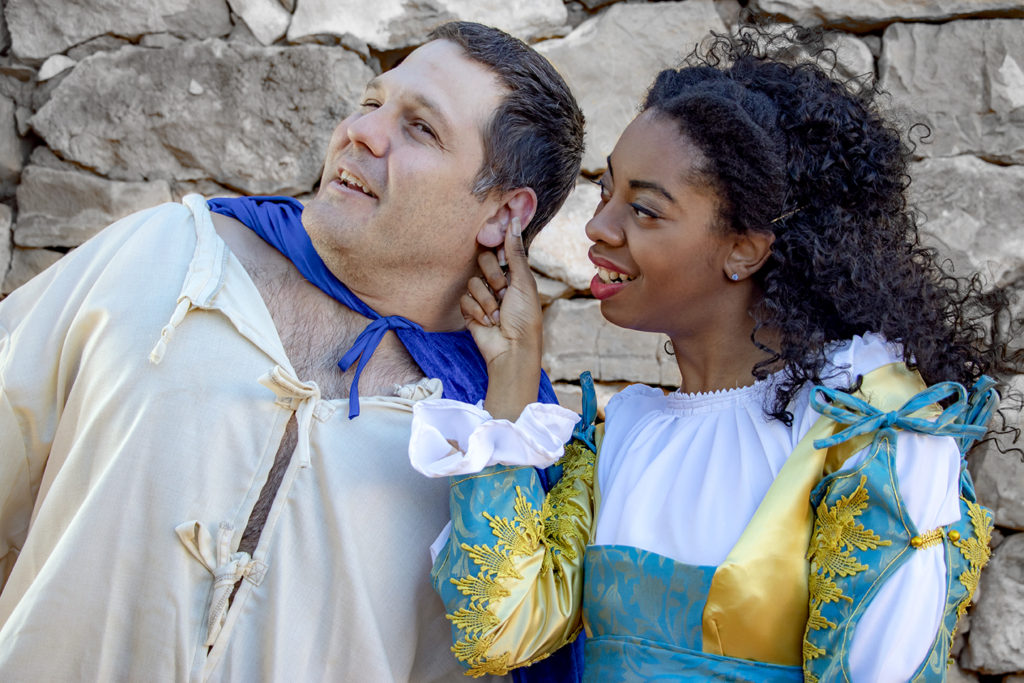
 What has been your favorite role with FlagShakes?
What has been your favorite role with FlagShakes? 
